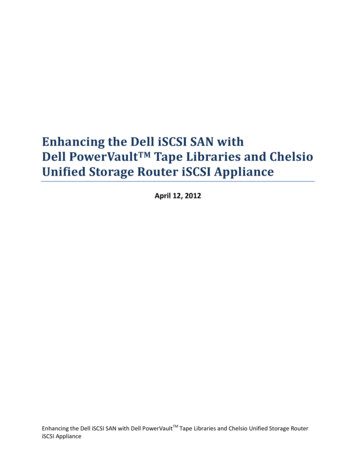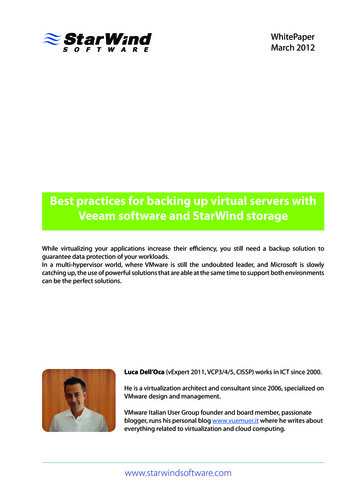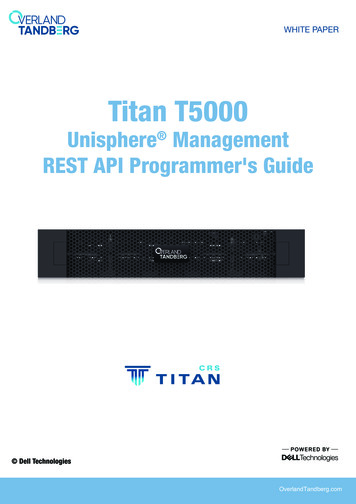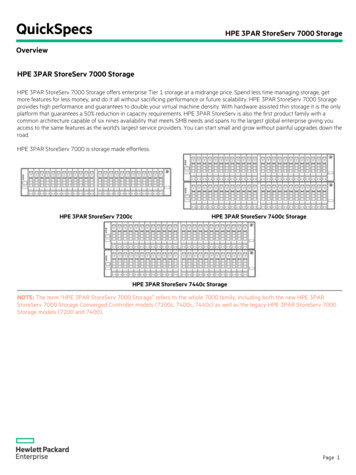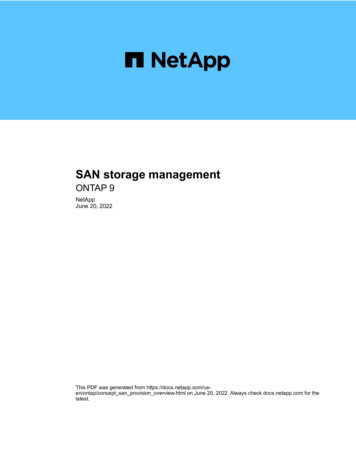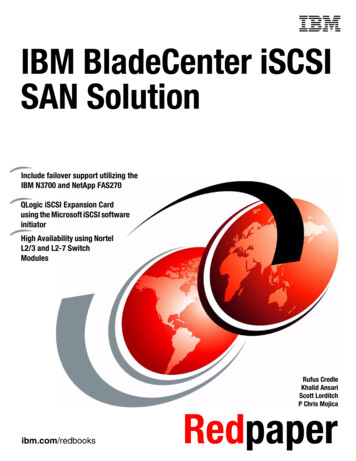
Transcription
Front coverIBM BladeCenter iSCSISAN SolutionInclude failover support utilizing theIBM N3700 and NetApp FAS270QLogic iSCSI Expansion Cardusing the Microsoft iSCSI softwareinitiatorHigh Availability using NortelL2/3 and L2-7 SwitchModulesRufus CredleKhalid AnsariScott LorditchP Chris MojicaRedpaperClick here to check for updatesibm.com/redbooks
International Technical Support OrganizationIBM BladeCenter iSCSI SAN SolutionAugust 2006
Note: Before using this information and the product it supports, read the information in “Notices” on page v.First Edition (August 2006)This edition applies to IBM BladeCenter, NetAPP FAS270 and N-Series N3700 storage system. Copyright International Business Machines Corporation 2006. All rights reserved.Note to U.S. Government Users Restricted Rights -- Use, duplication or disclosure restricted by GSA ADP ScheduleContract with IBM Corp.
ContentsNotices . . . . . . . . . . . . . . . . . . . . . . . . . . . . . . . . . . . . . . . . . . . . . . . . . . . . . . . . . . . . . . . . . .vTrademarks . . . . . . . . . . . . . . . . . . . . . . . . . . . . . . . . . . . . . . . . . . . . . . . . . . . . . . . . . . . . . . viPreface . . . . . . . . . . . . . . . . . . . . . . . . . . . . . . . . . . . . . . . . . . . . . . . . . . . . . . . . . . . . . . . . . viiThe team that wrote this Redpaper . . . . . . . . . . . . . . . . . . . . . . . . . . . . . . . . . . . . . . . . . . . . viiBecome a published author . . . . . . . . . . . . . . . . . . . . . . . . . . . . . . . . . . . . . . . . . . . . . . . . . viiiComments welcome. . . . . . . . . . . . . . . . . . . . . . . . . . . . . . . . . . . . . . . . . . . . . . . . . . . . . . . viiiChapter 1. iSCSI implementation with the IBM BladeCenter . . . . . . . . . . . . . . . . . . . . .1.1 Introduction . . . . . . . . . . . . . . . . . . . . . . . . . . . . . . . . . . . . . . . . . . . . . . . . . . . . . . . . . . .1.2 Why iSCSI versus Fibre Channel . . . . . . . . . . . . . . . . . . . . . . . . . . . . . . . . . . . . . . . . . .1.3 TOE benefits . . . . . . . . . . . . . . . . . . . . . . . . . . . . . . . . . . . . . . . . . . . . . . . . . . . . . . . . . .1.4 Software initiators . . . . . . . . . . . . . . . . . . . . . . . . . . . . . . . . . . . . . . . . . . . . . . . . . . . . . .1.5 Hardware initiators . . . . . . . . . . . . . . . . . . . . . . . . . . . . . . . . . . . . . . . . . . . . . . . . . . . . .1.6 Choosing between hardware and software initiators . . . . . . . . . . . . . . . . . . . . . . . . . . .1.7 QLogic iSCSI Expansion Card for IBM BladeCenter . . . . . . . . . . . . . . . . . . . . . . . . . . .1.8 Ethernet switch modules . . . . . . . . . . . . . . . . . . . . . . . . . . . . . . . . . . . . . . . . . . . . . . . . .1.9 Storage . . . . . . . . . . . . . . . . . . . . . . . . . . . . . . . . . . . . . . . . . . . . . . . . . . . . . . . . . . . . . .1.9.1 IBM System Storage N3700 . . . . . . . . . . . . . . . . . . . . . . . . . . . . . . . . . . . . . . . . . .1.9.2 NetApp FAS270 . . . . . . . . . . . . . . . . . . . . . . . . . . . . . . . . . . . . . . . . . . . . . . . . . . .1.9.3 IBM TotalStorage DS300 . . . . . . . . . . . . . . . . . . . . . . . . . . . . . . . . . . . . . . . . . . . .1223445566677Chapter 2. Boot from iSCSI SAN using iSCSI HBA and initiator with failover support 92.1 Important prerequisites . . . . . . . . . . . . . . . . . . . . . . . . . . . . . . . . . . . . . . . . . . . . . . . . . 102.2 Configuration overview . . . . . . . . . . . . . . . . . . . . . . . . . . . . . . . . . . . . . . . . . . . . . . . . . 112.2.1 Host configuration . . . . . . . . . . . . . . . . . . . . . . . . . . . . . . . . . . . . . . . . . . . . . . . . . 112.2.2 N3700 storage configuration . . . . . . . . . . . . . . . . . . . . . . . . . . . . . . . . . . . . . . . . . 122.2.3 Network configuration . . . . . . . . . . . . . . . . . . . . . . . . . . . . . . . . . . . . . . . . . . . . . . 122.3 Boot from iSCSI with failover support implementation . . . . . . . . . . . . . . . . . . . . . . . . . 132.3.1 Network configuration . . . . . . . . . . . . . . . . . . . . . . . . . . . . . . . . . . . . . . . . . . . . . . 152.3.2 N3700 storage configuration . . . . . . . . . . . . . . . . . . . . . . . . . . . . . . . . . . . . . . . . . 162.3.3 Host configuration - QLogic iSCSI Expansion Card for IBM BladeCenter . . . . . . 172.3.4 Operating system installation . . . . . . . . . . . . . . . . . . . . . . . . . . . . . . . . . . . . . . . . 262.3.5 Enable failover support for the boot disk. . . . . . . . . . . . . . . . . . . . . . . . . . . . . . . . 272.3.6 Multipath topology configuration . . . . . . . . . . . . . . . . . . . . . . . . . . . . . . . . . . . . . . 312.3.7 Verify end-to-end network connectivity . . . . . . . . . . . . . . . . . . . . . . . . . . . . . . . . . 362.3.8 Failover verification . . . . . . . . . . . . . . . . . . . . . . . . . . . . . . . . . . . . . . . . . . . . . . . . 42Chapter 3. iSCSI SAN High Availability . . . . . . . . . . . . . . . . . . . . . . . . . . . . . . . . . . . . . .3.1 Topology, naming, and addressing conventions used in these examples . . . . . . . . . .3.2 NetApp/IBM N3700 configurations . . . . . . . . . . . . . . . . . . . . . . . . . . . . . . . . . . . . . . . .3.2.1 IP addressing . . . . . . . . . . . . . . . . . . . . . . . . . . . . . . . . . . . . . . . . . . . . . . . . . . . .3.2.2 Initiators and Initiator groups. . . . . . . . . . . . . . . . . . . . . . . . . . . . . . . . . . . . . . . . .3.2.3 Storage array node name . . . . . . . . . . . . . . . . . . . . . . . . . . . . . . . . . . . . . . . . . . .3.3 QLogic iSCSI HBA and software configuration . . . . . . . . . . . . . . . . . . . . . . . . . . . . . . .3.3.1 Hardware and software installation . . . . . . . . . . . . . . . . . . . . . . . . . . . . . . . . . . . .3.3.2 SANsurfer configuration . . . . . . . . . . . . . . . . . . . . . . . . . . . . . . . . . . . . . . . . . . . .3.3.3 Network configuration . . . . . . . . . . . . . . . . . . . . . . . . . . . . . . . . . . . . . . . . . . . . . .3.3.4 Specification of targets . . . . . . . . . . . . . . . . . . . . . . . . . . . . . . . . . . . . . . . . . . . . . Copyright IBM Corp. 2006. All rights reserved.4546495051515151555758iii
3.4 Nortel switch configurations . . . . . . . . . . . . . . . . . . . . . . . . . . . . . . . . . . . . . . . . . . . . .3.5 High availability options and configurations . . . . . . . . . . . . . . . . . . . . . . . . . . . . . . . . .3.5.1 HA from storage . . . . . . . . . . . . . . . . . . . . . . . . . . . . . . . . . . . . . . . . . . . . . . . . . .3.5.2 HA from switches . . . . . . . . . . . . . . . . . . . . . . . . . . . . . . . . . . . . . . . . . . . . . . . . .64686868Appendix A. Install local hard disk for high-load environments . . . . . . . . . . . . . . . . . 69Appendix B. N-Series N3700 and NetApp FAS270 CPU Module. . . . . . . . . . . . . . . . . . 71Appendix C. Corresponding switch module configurations. . . . . . . . . . . . . . . . . . . . . 73Related publications . . . . . . . . . . . . . . . . . . . . . . . . . . . . . . . . . . . . . . . . . . . . . . . . . . . . .IBM Redbooks . . . . . . . . . . . . . . . . . . . . . . . . . . . . . . . . . . . . . . . . . . . . . . . . . . . . . . . . . . .Online resources . . . . . . . . . . . . . . . . . . . . . . . . . . . . . . . . . . . . . . . . . . . . . . . . . . . . . . . . .How to get IBM Redbooks . . . . . . . . . . . . . . . . . . . . . . . . . . . . . . . . . . . . . . . . . . . . . . . . . .Help from IBM . . . . . . . . . . . . . . . . . . . . . . . . . . . . . . . . . . . . . . . . . . . . . . . . . . . . . . . . . . .ivIBM BladeCenter iSCSI SAN Solution7575757676
NoticesThis information was developed for products and services offered in the U.S.A.IBM may not offer the products, services, or features discussed in this document in other countries. Consultyour local IBM representative for information on the products and services currently available in your area.Any reference to an IBM product, program, or service is not intended to state or imply that only that IBMproduct, program, or service may be used. Any functionally equivalent product, program, or service that doesnot infringe any IBM intellectual property right may be used instead. However, it is the user's responsibility toevaluate and verify the operation of any non-IBM product, program, or service.IBM may have patents or pending patent applications covering subject matter described in this document. Thefurnishing of this document does not give you any license to these patents. You can send license inquiries, inwriting, to:IBM Director of Licensing, IBM Corporation, North Castle Drive Armonk, NY 10504-1785 U.S.A.The following paragraph does not apply to the United Kingdom or any other country where such provisionsare inconsistent with local law: INTERNATIONAL BUSINESS MACHINES CORPORATION PROVIDES THISPUBLICATION “AS IS” WITHOUT WARRANTY OF ANY KIND, EITHER EXPRESS OR IMPLIED,INCLUDING, BUT NOT LIMITED TO, THE IMPLIED WARRANTIES OF NON-INFRINGEMENT,MERCHANTABILITY OR FITNESS FOR A PARTICULAR PURPOSE. Some states do not allow disclaimer ofexpress or implied warranties in certain transactions, therefore, this statement may not apply to you.This information could include technical inaccuracies or typographical errors. Changes are periodically madeto the information herein; these changes will be incorporated in new editions of the publication. IBM may makeimprovements and/or changes in the product(s) and/or the program(s) described in this publication at any timewithout notice.Any references in this information to non-IBM Web sites are provided for convenience only and do not in anymanner serve as an endorsement of those Web sites. The materials at those Web sites are not part of thematerials for this IBM product and use of those Web sites is at your own risk.IBM may use or distribute any of the information you supply in any way it believes appropriate withoutincurring any obligation to you.Information concerning non-IBM products was obtained from the suppliers of those products, their publishedannouncements or other publicly available sources. IBM has not tested those products and cannot confirm theaccuracy of performance, compatibility or any other claims related to non-IBM products. Questions on thecapabilities of non-IBM products should be addressed to the suppliers of those products.This information contains examples of data and reports used in daily business operations. To illustrate themas completely as possible, the examples include the names of individuals, companies, brands, and products.All of these names are fictitious and any similarity to the names and addresses used by an actual businessenterprise is entirely coincidental.COPYRIGHT LICENSE:This information contains sample application programs in source language, which illustrates programmingtechniques on various operating platforms. You may copy, modify, and distribute these sample programs inany form without payment to IBM, for the purposes of developing, using, marketing or distributing applicationprograms conforming to the application programming interface for the operating platform for which the sampleprograms are written. These examples have not been thoroughly tested under all conditions. IBM, therefore,cannot guarantee or imply reliability, serviceability, or function of these programs. You may copy, modify, anddistribute these sample programs in any form without payment to IBM for the purposes of developing, using,marketing, or distributing application programs conforming to IBM's application programming interfaces. Copyright IBM Corp. 2006. All rights reserved.v
TrademarksThe following terms are trademarks of the International Business Machines Corporation in the United States,other countries, or both:Eserver Eserver Redbooks (logo)eServer iSeries xSeries AIX BladeCenter IBM Redbooks System x System Storage TotalStorage The following terms are trademarks of other companies:Active Directory, Microsoft, Windows, and the Windows logo are trademarks of Microsoft Corporation in the United States,other countries, or both.NetApp, the Network Appliance logo, the bolt design, are registered trademarks of Network Appliance, Inc. in the U.S. andother countries.QLogic, the QLogic logo SANbox, SAN Pro and SAN Express are registered trademarks of QLogic Corporation.Other company, product, or service names may be trademarks or service marks of others.viIBM BladeCenter iSCSI SAN Solution
PrefaceThis IBM Redpaper provides the instructions to configure an IBM BladeCenter Boot fromiSCSI NAS from the IBM N-Series N3700 storage system. Our Boot from the iSCSI NAS testenvironment included the use of the Nortel and Cisco Switch Modules for the IBMBladeCenter. We also discuss High Availability utilizing the Nortel Networks L2-3 and L2-7Switch Modules for the IBM BladeCenter.The team that wrote this RedpaperThis Redpaper was produced by a team of specialists from around the world working at theInternational Technical Support Organization, Raleigh Center.Rufus Credle is a Certified Consulting IT Specialist at the ITSO, Raleigh Center. In his roleas Project Leader, he conducts residencies and develops IBM Redbooks about networkoperating systems, ERP solutions, voice technology, high availability and clustering solutions,Web application servers, pervasive computing, and IBM and OEM e-business applications,all running IBM System x and IBM BladeCenter. Rufus's various positions during his IBMcareer have included assignments in administration and asset management, systemsengineering, sales and marketing, and IT services. He holds a BS degree in businessmanagement from Saint Augustine's College. Rufus has been employed at IBM for 26 years.Khalid Ansari is the Technical Team Lead for the IBM Blade Infrastructure Solution Centerteam in Research Triangle Park, North Carolina. His responsibilities include assistingBladeCenter pre-sale customers world-wide with new proof of concepts and pilot testing. Hehas developed numerous technical documents and best practices procedures forBladeCenter complex technology solutions. He was a participant in developing the IBMStorage Networking Solutions V1 Certification. Khalid started with IBM in August 1998 as anATM Networking Specialist in Level 2 support and later worked in SAN Solutions support.Scott Lorditch is a Sales Network Architect for Blade Network Technologies, Inc. (formerlythe Blade Switching Server business unit of Nortel Networks). He develops designs andproposals for customers and potential customers of Blade Network Technologies, Inc.GbESM products for the IBM BladeCenter, including overall network architectureassessments. He has also developed several training and lab sessions for IBM technical andsales personnel and has provided field feedback to the product team. His background beforeworking for Blade Network Technologies, Inc., includes almost 20 years working onnetworking, including electronic securities transfer projects for a major bank based in NewYork City, as a Senior Network Architect for a multi-national soft drink company, and asProduct Manager for managed hosting services for a large telecommunications provider. Heholds a BS in Operations Research with specialization in Computer Science from CornellUniversity.P Chris Mojica is a Staff Systems Engineer for QLogic supporting various IBM xSeries andiSeries groups with pre-sales and post-sales responsibilities. He joined QLogic in 2001 andhas supported multi-generational OEM product life spans and published numerouswhitepapers and design guides focusing on subjects from chip level design to boot from SAN.Prior to coming to QLogic Chris had successful careers in the networking and broadbandfields as a Network Systems Consultant with Lucent Network Care division, formerlyInternational Network Services, and as a Field Applications Engineer with Xpeed Corporation.Chris began his professional career co-oping with IBM Network Hardware Division. Copyright IBM Corp. 2006. All rights reserved.vii
Thanks to the following people for their contributions to this project:Tamikia Barrows, Jeanne Tucker, Margaret TicknorInternational Technical Support Organization, Raleigh CenterKenny Speer, Senior Engineer, SAN InteroperabilityNetwork Appliance RTPKalman Z. Meth, Ph.D. and Julian SatranIBM Haifa LabsMadhav Ponamgi, Computational Scientist, Advanced Technical Services LifeSciences/HealthcareIBM Furlong PAFabiano Matassa, ITAIBM United KingdomDavid Tareen, Product Marketing Manager - StorageIBM Research Triangle ParkShawn Andrews, e-Server Storage DevelopmentIBM Research Triangle ParkRobert Ray, IBM System x Systems EngineerIBM CincinnatiBecome a published authorJoin us for a two- to six-week residency program! Help write an IBM Redbook dealing withspecific products or solutions, while getting hands-on experience with leading-edgetechnologies. You'll team with IBM technical professionals, Business Partners, or customers.Your efforts will help increase product acceptance and customer satisfaction. As a bonus,you'll develop a network of contacts in IBM development labs, and increase your productivityand marketability.Find out more about the residency program, browse the residency index, and apply online at:ibm.com/redbooks/residencies.htmlComments welcomeYour comments are important to us!We want our papers to be as helpful as possible. Send us your comments about thisRedpaper or other Redbooks in one of the following ways: Use the online Contact us review redbook form found at:ibm.com/redbooks Send your comments in an email to:redbook@us.ibm.comviiiIBM BladeCenter iSCSI SAN Solution
Mail your comments to:IBM Corporation, International Technical Support OrganizationDept. HYTD Mail Station P0992455 South RoadPoughkeepsie, NY 12601-5400Prefaceix
xIBM BladeCenter iSCSI SAN Solution
1Chapter 1.iSCSI implementation with theIBM BladeCenterThis chapter discusses those items to be considered when implementing an IBMBladeCenter Boot from the iSCSI SAN solution and the products we used for our testenvironment. Copyright IBM Corp. 2006. All rights reserved.1
1.1 IntroductionThere are two main ways to implement iSCSI in general, and specifically on Blade serverswithin a BladeCenter chassis. The two options are to use hardware initiators or softwareinitiators. It is generally not possible to use both on the same server at the same time, butiSCSI will not work without one of these two options.1.2 Why iSCSI versus Fibre ChannelThe iSCSI protocol is a transport for SCSI over TCP/IP. Until recently, standard IP protocolinfrastructure (for example, Ethernet) could not provide the necessary high bandwidth andlow-latency needed for storage access. Special communications infrastructure, mainly FibreChannel running FCP (SCSI over Fibre Channel), was developed to allow for Storage AreaNetworks (SANs). With the recent advances in Ethernet technology, it is now practical (from aperformance perspective) to access storage devices over an IP network. 1 Gigabit Ethernet isnow widely available and is competitive with 1 and 2 Gigabit Fibre Channel. 10 GigabitEthernet is readily coming available. Similar to FCP, iSCSI allows storage to be accessedover a Storage Area Network, allowing shared access to storage. A major advantage of iSCSIover FCP is that iSCSI can run over standard, off-the-shelf Ethernet network components. Anetwork that incorporates iSCSI SANs need use only a single kind of network infrastructure(Ethernet) for both data and storage traffic, while use of FCP requires a separate type ofinfrastructure (Fibre Channel) and administration for the storage. Furthermore, iSCSI (TCP)based SANs can extend over arbitrary distances, and are not subject to distance limitationsthat currently limit FCP.Since iSCSI is designed to run on an IP network, it can take advantage of existing featuresand tools that were already developed for IP networks. The very use of TCP utilizes TCP’sfeatures of guaranteed delivery of data and congestion control. IPSec can be leveraged toprovide security of an iSCSI SAN, while a new security mechanism may have to bedeveloped for the Fibre Channel. Service Location Protocol (SLP) can be used by iSCSI todiscover iSCSI entities in the network. Thus, in addition to iSCSI running on standard,cheaper, off-the-shelf hardware, iSCSI also benefits from using existing, standard IP-basedtools and services.Note: Fibre Channel security is available. It is defined by the T11 organization (that definesall the Fibre Channel specs). It is the FC-SP spec and can be found at the following 7v0.pdf2IBM BladeCenter iSCSI SAN Solution
Classic entsData atabaseServerWebServerStorageFibre ChannelNetworkStorageFileServerData and StorageIP NetworkStorageFigure 1-1 Classic SAN and an iSCSI SAN topologyNote: Where the Boot from iSCSI or Fibre Channel SAN would serve and satisfy therequirements of several client environments, there are some engineering and scientificapplications that require the use of the local disk for better performance and may not befeasible for a Boot from iSCSI or Fibre Channel SAN solution. For example: Nastran (linear finite element analysis codes for engineering)Dytran (non-linear finite element analysis)Marc (another non-linear code)Fluent (fluid dynamics)Gaussian (computation chemistry)Amber (computational chemistry)GCG (computational chemistry)Therefore, you should know your applications and where best they should be run.1.3 TOE benefitsWe know that the processing of TCP packets from an Ethernet connection consumes manyCPU resources, and iSCSI protocol only adds another layer of processing. With the numberof packets and their corresponding interrupts required for iSCSI, the software iSCSI packetprocessing can burden the host system with 50–65% CPU usage. Depending upon thesignaling options used, high CPU usage may even render some host applications unusable.Therefore, it is important that efficient iSCSI systems depend on a hardware TCP OffloadEngine (TOE) to handle the transportation protocols of iSCSI. A TOE network interface cardChapter 1. iSCSI implementation with the IBM BladeCenter3
(NIC) is a special interface card specifically designed for interfacing a server to the IP-SANand will offload iSCSI as well and TCP/IP encapsulation from the server CPUs. A hardwareTOE implements the entire standard TCP and iSCSI protocol stacks into the hardware. Thisapproach completely offloads the iSCSI protocol from the primary CPU, processing storagecommunications efficiently and enabling applications to run faster and more reliably. By usingthe TCP Offload Engine, a single system can run multiple initiators for improved throughput.In our Boot from iSCSI example, we use the QLogic iSCSI Expansion Card for IBMBladeCenter. This iSCSI Expansion Card option is a hardware initiator that provides iSCSIcommunication from the blade server to an iSCSI storage device. It delivers full TCP/IPOffload Engine (TOE) functionality to reduce CPU processing. For more information view theWeb link:http://www-306.ibm.com/common/ssi/rep ca/4/897/ENUS105-194/ENUS105-194.PDF1.4 Software initiatorsA configuration that uses software initiators includes the following: Microsoft iSCSI software initiator or equivalent. The Microsoft software is used in theexamples that follow. One or two Ethernet switch modules, preferably the use of two Ethernet switch modulesfor high availability. There is no daughter card required on the server blades to implement a connection to aniSCSI SAN environment. However, it is possible to use an Ethernet daughter card anddeploy Ethernet switch modules in I/O module bays 3 and 4 in addition to the Ethernetswitch modules for data networking in bays 1 and 2. For our example in Chapter 2, “Bootfrom iSCSI SAN using iSCSI HBA and initiator with failover support” on page 9, it wasnecessary that we use a TOE network interface card (QLogic HBA) and Microsoft softwareinitiator to successfully implement a boot from iSCSI and failover solution.Note: If you are using BladeCenter bays 3 and 4, you will need an iSCSI daughter cardor an Ethernet daughter card installed on the blade. If not, your blade will not haveconnectivity to the storage subsystems via the switch modules in bays 3 and 4.Announcement: In April 2006, Microsoft announced that it will supply select partnerswith specialized code that allows them to toggle the boot order, making a boot fromiSCSI SAN possible and supported. Two of Microsoft's partners are IBM and emBoot,with its WinBoot/i iSCSI boot-from-SAN software initiator.For more information about Microsoft support for iSCSI visit the following Web chnologies/storage/iscsi/msfiSCSI.mspx1.5 Hardware initiatorsA configuration that uses hardware initiators includes the following: An iSCSI daughter card for each blade, which will access the storage array, and theassociated drivers and other software. The examples that follow later in this Redpaperused the QMC4052 card from QLogic.4IBM BladeCenter iSCSI SAN Solution
One or two Ethernet switch modules, preferably the use of two Ethernet switch modulesfor high availability. Note that these switch modules can only be installed in I/O modulebays 3 and 4. As above, the examples that follow in this Redpaper were tested usingNortel Networks L2/3 ESM and the Cisco Systems Intelligent GbESM for IBMBladeCenter. The BladeCenter Management Module will detect if there is a conflict between thedaughter cards installed on the server blades and the switch modules installed in I/O bays3 and 4. It will disable power to the switch modules or connectivity to the blades to preventdamage to any of the parts inserted in the chassis.1.6 Choosing between hardware and software initiatorsThe key benefits of using hardware initiators are: Their performance will be noticeably faster. They will not interfere with data networking traffic if the network topology is designed tosegregate storage traffic such as by using a different set of switches to connect servers toiSCSI storage. The traffic that passes through them will not load the server's CPU to the same extent thatwould be the case if the storage traffic passed through the standard IP stack. It is possible to implement iSCSI boot from SAN with hardware initiators.Note: At the time of the writing of this Redpaper, Microsoft announced that it will makeits software initiator capable of booting from iSCSI SAN possible and supported.The key benefits of using software initiators are: The cost of the hardware (daughter cards) is avoided. It is possible to use one set of switches for both data and storage networking, avoiding thecost of additional switches but possibly impacting performance. It is possible to access other networked storage devices such as NAS, NFS, or other fileservers using the same network interfaces as are used for iSCSI.1.7 QLogic iSCSI Expansion Card for IBM BladeCenterThe iSCSI Expansion Card option (p/n 32R1923) is a hardware initiator that provides iSCSIcommunication from the blade server (HS20, HS40, JS20, and LS20) to an iSCSI storagedevice (target).With the iSCSI Expansion Card, you gain: Full hardware-based iSCSI initiator and TOE for storage traffic only function (true TOEadapter as well as full iSCSI offload HBA, allows host processor hand off storageprocessing so it can worry about host application processing) Blades enabled to run diskless in a non-Fibre Channel SAN environment (Boot fromiSCSI) Dual port card utilizing QLogic QMC4052 enabling iSCSI connectivity through switchmodule bays 3 and 4Chapter 1. iSCSI implementation with the IBM BladeCenter5
– Since HBA is presented as a true SCSI storage adapter (hiding the iSCSI interface)application interoperability is guaranteed.– Supports NIC and iSCSI functionality on both channels simultaneously. Easy-to-use GUI and CLI to manage the HBA Standard BladeCenter expansion card form factor (full-sized expansion card) NEBS-compliant for use in NGN/Telco environments Fully interoperable with DS300, N3700, N5200, N5500, IBM SDLT/LTO, IBM TapeSLX Fully interoperable with RHEL3 and 4, SLES 8 and 9, Windows 2000/2003, and (AIX 5.2 and 5.3 (JS20 and JS21 only))The portfolio now includes iSCSI-SCSI over Ethernet. iSCSI technology combines Ethernet,SCSI, and TCP/IP to deliver a non-Fibre Channel SAN using stable and familiar standards.Ultimately, iSCSI is a viable alternative to local IDE and local SCSI drives, allowing customersto run servers in a diskless/stateless environment.For more information see the announcement at the following site:http://w3-3.ibm.com/sales/ssi/rep ca/7/897/ENUSC05-027/ENUSC05-027.PDF1.8 Ethernet switch modulesThe supported Ethernet switch modules for the IBM BladeCenter and suggested for the Bootfrom iSCSI solution referred to in this chapter are: Nortel Networks Layer 2/3 Fiber Gigabit Ethernet Switch Module for IBM BladeCenterNortel Networks Layer 2/3 Copper Gigabit Ethernet Switch Module for IBM BladeCenterNortel Networks Layer 2-7 Gigabit Ethernet Switch Module for IBM BladeCenterCisco Systems Fiber Intelligent Gigabit Ethernet Switch Module for IBM BladeCenterCisco Systems Intelligent Gigabit Ethernet Switch Module for IBM BladeCenterServer Connectivity Module for IBM BladeCenterMore information about each switch module can be viewed at the following Web tch/switch ethernet overview.htmlAttention: As of February 2006, the Nortel switch modules were acquired by BladeNetwork Technologies:http://www.bladenetwork.net/1.9 StorageIn our Boot fro
career have included assignments in administration and asset management, systems engineering, sales and marketing, and IT services. He holds a BS degree in business management from Saint Augustine's College. Rufus has been employed at IBM for 26 years. Khalid Ansari is the Technical Team Lead for the IBM Blade Infrastructure Solution Center

